Never Too Young
by Leonard Gibson and Laurie Haney
Reprinted from "Crown Jewels of the Wire", April 2002, page 9
Using insulators as a teaching tool.
In early 2000, my daughter said that she would like to go to the NIA annual
show in Bloomington, MN to keep her mother company, (while shopping at Mall of
America), while I did the insulator show.
At the show, while viewing an exhibit
by an elementary aged child and learning later that he was encouraged/inspired
by his grandfather, Laurie became intrigued and wondered, "How could my
father share his passion for the hobby with my class of thirty young children
ages 4-1/2 to 6 years old?"
Shortly after school started in September 2000,
Laurie asked if I would help her develop a month long classroom program using
insulators as a teaching tool. I gladly accepted. She began gathering ideas and
developing a master plan for her insulator unit. By January 2001, she had a plan
ready and chose to implement it during the month of April 2001.
During the first
week of April, as an introduction to the unit, Laurie buried two insulators in a
tub of dirt. Two children discovered the insulators while playing in the dirt.
She then asked each child in her class what they thought they were. She made a
list of their answers. As a follow-up, Laurie explained to her class what
insulators are and that her father would be coming the next day, bringing
examples of different types of insulators with him. The class would be studying
these insulators over the next three weeks.
I gave the class a brief history of
why insulator are used and where they were first used. I also told them that
insulators are still being used today and that we would go outside to look for
them at the top of telephone/power poles. I had them guess at the nicknames of
the insulators. The children guessed "Mickey Mouse" and
"Spaceship."
|
WHAT ARE INSULATORS?
|
|
(Question asked at the beginning of the unit)
|
|
DARRAH -
|
They are glass.
|
|
CARLY -
|
I think they are made of glass.
|
|
COREY -
|
I
think they are from Laurie's dad.
|
|
ALEXANDER -
|
I think they are used for bugs.
|
|
DUNCAN -
|
They are breakable.
|
|
ANNA -
|
I think they are half an insulator.
|
GARRET -
|
They are glass.
|
NICHELLE -
|
Two broken pieces of insulators.
|
GRACE -
|
I think
Laurie's dad made them.
|
RACHEL -
|
They are for caterpillars
|
JACKSON -
|
They are
cameras.
|
CHRISTIAN -
|
Dirt tubes.
|
TORVALD -
|
They are a type of glass.
|
HAVEN -
|
They look like Ariel.
|
HUNTER -
|
They are a type of glass.
|
URIAH -
|
They are a type
of glass things.
|
BLAKE -
|
They are stapled to glass.
|
EZRA -
|
They are glass
things.
|
MCKENNA -
|
They are glass.
|
KATIE -
|
Things you can look at and decorate.
|
WESTON -
|
They are made out of clay and turned into glass.
|
SARAH -
|
They are
lights.
|
JONATHAN -
|
They are made from glass that you can get from buildings.
|
MATTHEW -
|
They look like glass people.
|
MARCUS -
|
They are from clay and dry
solid.
|
|
If they didn't like the nickname, they changed it. (i.e., "hoopskirt: to
"spaceship") If the insulator didn't have a nickname, they gave it one
(i.e., "water bottle", "alien", and "alien ship").
The last one I held up looked like a "bullet" and they all guessed
that one. Then we went outside to look for insulators in use around the school's
neighborhood. They enjoyed looking through my binoculars. One little boy would
not leave my side. When we went back inside, the children sang the song
"Here We Go To The Insulator Show," written by Laurie Haney.
In
conclusion, I told them that I would come back in three weeks and I would bring
each one of them their very own insulator. The children kept asking Laurie,
"When is your daddy coming back and bringing our insulator?" Finally,
Laurie had to mark the school calendar.
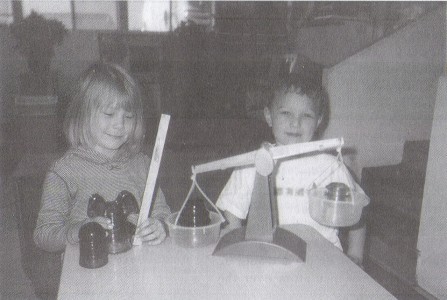
Two children measure and weigh the insulators.
During the next three weeks, Laurie had
activities planned, using insulators in the areas of:
MATH
Classifying by shape, color, size and marks; Weighing; Measuring; Making patterns;
Graphing our favorite insulator.
PHYSICAL EDUCATION
A game called "Insulators On The Telephone Pole"
ART
Making clay telephone poles; Painting with insulators.
LANGUAGE
Talking about similarities and differences; Matching the glass
company embossed on the insulator; Labeling the insulators parts.
SCIENCE
Talking about electricity; Working on the coloring book given to the
children by a parent who is an Electrical Engineer; Making a collage using
pictures of electric items; Making a list of how we can save electricity.
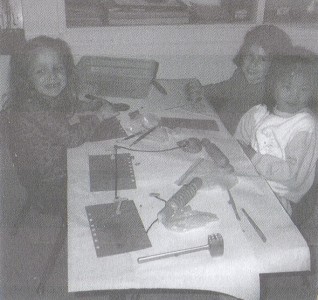
Three students making telephone poles out of clay.
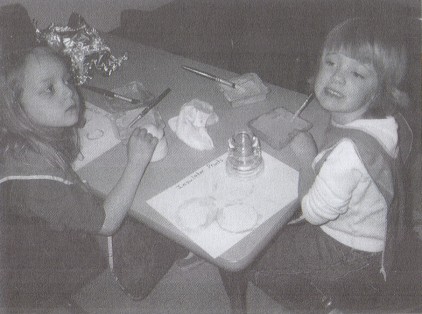
Two girls painting their insulators.
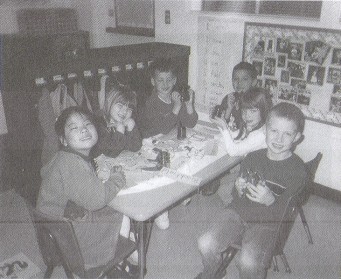
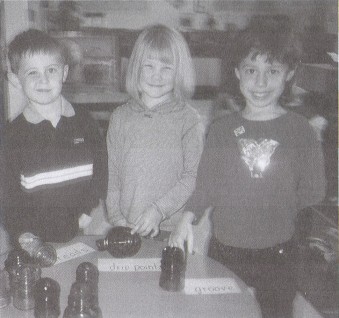
Students match embossings and company names
and learn the parts of an
insulator.
During snack time, a little boy ate a cracker down to a shape of an insulator
and then proceeded to tell the teacher the parts (i.e., dome, base, grooves,
etc.) Laurie named the new insulator design, "The Cracker"!
I visited
the class again at the end of the fourth week and talked about why people
collect insulators. I showed them a video clip of a real insulator show. Then
Laurie and I set up a mock insulator show and divided thirty insulators into
groups of six. We priced each group from fifty cents to two dollars. The
children were given about three dollars in "play money" to purchase an
insulator. After they picked their insulator, they went to the
"cashier" and paid. The cashier explained how much change they would
be getting back and another teacher helped them wrap their insulator. The
insulators were put into paper bags with their name on it. Several of the
"buyers" wanted an insulator with sharp drip points.

The Insulator Show featuring four students,
Leonard Gibson and his daughter,
Laurie Haney.
Closure: Before I came back the second time, Laurie asked the children what
they had learned about insulators. With this list, the class made a book about
insulators for me.
|
WHAT HAVE YOU LEARNED ABOUT INSULATORS?
|
|
(Question asked at the end of the
unit)
|
|
DARRAH -
|
They have different bases.
|
|
CARLY -
|
Some are different colors and
some are not.
|
|
COREY -
|
The different colors.
|
|
ALEXANDER -
|
They are not all the
same size.
|
DUNCAN -
|
Insulators don't come from just one company.
|
ANNA -
|
We
couldn't touch them because they break.
|
GARRET -
|
My grandfather has insulators
at his house.
|
NICHELLE -
|
They all have different glass companies.
|
GRACE -
|
They
go on top of the telephone poles.
|
RACHEL -
|
Some are big and some are little.
|
JACKSON -
|
They hold the telephone wires.
|
CHRISTIAN -
|
I learned about the base,
crown and drip points.
|
TORVALD -
|
Insulators are heavy.
|
HAVEN -
|
They are not the
same.
|
HUNTER -
|
I learned that wires wrap around insulators.
|
URIAH -
|
They are not
all the same shape and color.
|
EZRA -
|
They hold wires and electricity goes
through it.
|
MCKENNA -
|
They are not all the same shape.
|
KATIE -
|
I learned about
the skirt and the different colors. Some have lines.
|
WESTON -
|
Some telephone
poles do not have insulators on them.
|
SARAH -
|
They arc different colors.
|
JONATHAN -
|
They hold the wires up.
|
MATTHEW -
|
They hold the telephone wires.
|
MARCUS -
|
They come in different shapes.
|
|
They drew a picture and they told Laurie what their picture was about. She
wrote down their answers because many of the children have not developed writing
skills.

Laurie Haney's dad, Leonard Gibson,
enjoys the book about insulators.
When I first conceived of this program, I had no idea how it would interest
this age group. This unit has not been taught at Portland, Oregon's West Hills
Schools -- Early Childhood Learning Program before. Surprisingly, it was a great
success and a good learning experience for everyone. One little boy has started
a collection. By August 2001, he had about twenty-three insulators. He wants
my dad to get him a CD 258 "Viking Helmet". This child was afraid to
put his face under water during swimming lessons. So, I bet him an insulator
that he could not do it. I lost!
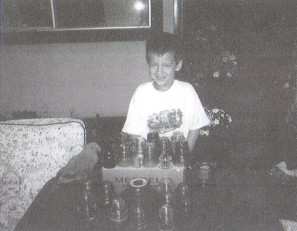
Another boy collected the insulators lying
around his grandfather's farm with his dad. One father started collecting
insulators because his son talked about them so much.
While riding in the car, a
little girl drove her parents crazy by pointing out all the insulators she saw.
A lot of the children were amused because they knew something their family did
not know. Another little girl would fret to her mom about where she was going to
put her insulator. The insulator had to be in a "perfect place. "
Another child placed his insulator in his bedroom window and made a special
curtain for it. He taped up a sign that said "DO NOT OPEN". Some of
the youngsters insisted that their insulator be displayed in the living room,
family room or kitchen window. One boy took a picture of his insulator with his
own camera. A little girl from Germany, who spoke very little English, drew a
picture of me teaching insulators to the class.
A month after the unit was over,
the children and parents were still talking about insulators. Because of its
success, I have been asked to do the unit again. We begin this month, and this time I will have "Six
Little Insulator Experts" helping me out.
After reading several articles in
"Crown Jewels of the Wire ", I suggested to my dad that we write this
article. We are also creating an exhibit for the NIA national convention in Fort
Collins, Colorado, July 5-7, 2002. So, why not attend the show and see what the
Class of 2002 comes up with in the way of insulator knowledge?
---- Laurie Haney
|
Here We Go To An Insulator Show
(Tune: Here We Go Round the Mulberry Bush)
Here we go to an insulator show, insulator show, insulator show, Here we got
to an insulator show, so early in the morning.
This is the way we drive to an insulator show, drive to an insulator show,
drive to an insulator show. This is the way we drive to an insulator show, so
early in the morning.
This is the way we look at insulators, look at insulators, look at
insulators, This is the way we look at insulators, at an insulator show.
This is the way we buy insulators, buy insulators, buy insulators, This is
the way we buy insulators, at an insulator show.
This is the way we pack insulators, pack insulators, pack insulators. This is
the way we pack insulators, at an insulator show.
This is the way we drive back home, drive back home, drive back home, This is
the way we drive back home, late in the afternoon.
This is the way we unpack insulators, unpack insulators, unpack insulators,
This is the way we unpack insulators, late in the afternoon.
This is the way we clean insulators, clean insulators, clean insulators, This
is the way we clean insulators, late in the afternoon.
This is the way we display insulators, display insulators, display
insulators, This is the way we display insulators, at our home.
We are proud of our insulators, proud of our insulators, proud of our
insulators, We are proud of our insulators, we bought at the insulator show.
Revised by Laurie Haney
|
|
